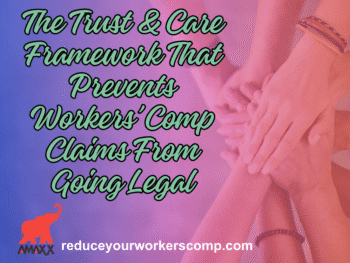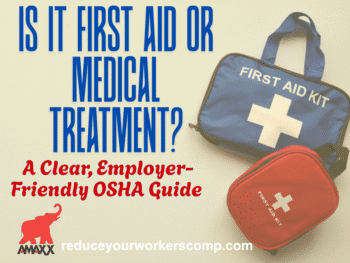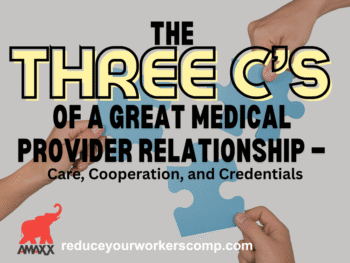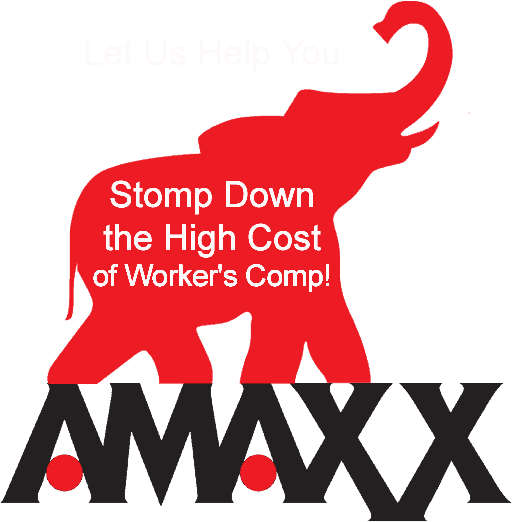
Think You’re Too Big to Worry About Frequency? Think Again
When a large company faces a single catastrophic injury, it grabs attention—and rightly so. These severe losses can be emotionally and financially draining. But while…
Think You’re Too Big to Worry About Frequency? Think AgainRead More

Can a High Deductible Plan Help Lower Your Mod?
When it comes to structuring your workers’ compensation insurance, high deductible plans offer flexibility, savings potential, and a level of control that guaranteed cost programs…

The 70% Discount You Might Be Missing in Workers’ Comp
Many employers worry that reporting small injuries will automatically raise their workers’ comp premiums. It’s an understandable concern—especially when trying to keep your experience modification…
The 70% Discount You Might Be Missing in Workers’ CompRead More

Building Partnerships, Not Transactions: The Secret to Better Claims Outcomes
Workers’ comp has evolved dramatically over the past 20 years—virtual staffing, remote adjusters, digital claims systems, automated reporting, telemedicine. But for all the technological progress, …
Building Partnerships, Not Transactions: The Secret to Better Claims OutcomesRead More

Building Your Workers’ Comp Dream Team
One of the biggest reasons workers’ comp programs fail is simple: no one is clearly in charge.Everyone assumes someone else is handling something—reporting, return to…

Your Workers’ Comp Oasis: Why Vision Comes Before Action
Most employers enter workers’ comp the same way Bugs Bunny handled that sinking rowboat—plugging leaks, reacting, scrambling, drowning in chaos. A claim pops up, then…
Your Workers’ Comp Oasis: Why Vision Comes Before ActionRead More

The Day-One Strategy That Determines Whether You Win or Lose a Claim
Most employers think winning a litigated workers’ comp case depends on the attorney’s performance at trial. You win cases long before trial even exists. Winning…
The Day-One Strategy That Determines Whether You Win or Lose a ClaimRead More

The $50,000 Question: “What Do You Think?” and Why Employers Should Ask It More
Early engagement with defense counsel. Not when the claim is denied.Not when the IME is ordered.Not when the trial date is set. But at the…
The $50,000 Question: “What Do You Think?” and Why Employers Should Ask It MoreRead More

The Trust & Care Framework That Prevents Workers’ Comp Claims From Going Legal
When employers talk about building a best-in-class workers’ compensation program, they usually jump straight to processes, vendors, adjusters, or metrics. But the true backbone of…
The Trust & Care Framework That Prevents Workers’ Comp Claims From Going LegalRead More

The #1 Question Employers Ask: Should We Pay Small Claims Out of Pocket?
One of the most common questions employers ask is: “Should we report small claims to the carrier,or just pay them out of pocket?” This question…
The #1 Question Employers Ask: Should We Pay Small Claims Out of Pocket?Read More

The 70% Secret: How the ERA Cuts Your Mod Faster Than Anything Else
The Experience Rating Adjustment (ERA) is one of the most powerful, most overlooked cost-reduction tools in workers’ compensation. In ERA states, medical-only claims receive a…
The 70% Secret: How the ERA Cuts Your Mod Faster Than Anything ElseRead More

The 48-Month Trap: How One Bad Workers’ Comp Year Impacts Your Mod for Three More
A bad workers’ comp year can feel like a disaster. A cluster of injuries, a catastrophic loss, or a period of high frequency will drive…
The 48-Month Trap: How One Bad Workers’ Comp Year Impacts Your Mod for Three MoreRead More

One Injury, One Dataset: How to Create a Seamless Safety–Work Comp Workflow
One of the most costly inefficiencies in injury management comes from the way employers collect and handle data. OSHA data lives in one silo. Workers’…
One Injury, One Dataset: How to Create a Seamless Safety–Work Comp WorkflowRead More

Is It First Aid or Medical Treatment? A Clear, Employer-Friendly OSHA Guide
One of the most misunderstood areas of OSHA compliance is the difference between first aid and medical treatment beyond first aid. And while it might…
Is It First Aid or Medical Treatment? A Clear, Employer-Friendly OSHA GuideRead More

Using Data to Strengthen Your Provider Relationships
Numbers don’t replace relationships — but they can make them stronger. In today’s workers’ compensation landscape, employers have access to more data than ever before,…
Using Data to Strengthen Your Provider RelationshipsRead More

The Three C’s of a Great Medical Provider Relationship — Care, Cooperation, and Credentials
Behind every well-managed claim stands a well-chosen provider. In workers’ compensation, medical treatment isn’t just about diagnosing injuries — it’s about guiding people through one…
The Three C’s of a Great Medical Provider Relationship — Care, Cooperation, and CredentialsRead More
Breakthrough Approaches Transforming Orthopedic Recovery: Experts Take the Stage at National Comp 2025
From limb restoration and joint preservation to advanced nerve reconstruction, new technologies in orthopedics are transforming how injured workers heal and return to work. At…

The Hidden Costs of Discount-Driven Medical Networks
At first glance, “discount” sounds like a good deal. Every employer wants to believe that a 30% or 40% reduction in medical costs means their…
The Hidden Costs of Discount-Driven Medical NetworksRead More

The Story Your Data Should Tell – Part 3: Turning Numbers Into a Narrative That Drives Change
Data alone doesn’t inspire people. Stories do.You can present all the charts, metrics, and reports you want — but until your audience understands the meaning…

Paradigm Expands Surgical Implant Review into Full-Scope Cost Management Solution
Industry-first program expands Paradigm’s established surgical implant review capabilities to deliver a comprehensive and cost-effective solution for the full scope of surgical procedures. Walnut Creek,…
Paradigm Expands Surgical Implant Review into Full-Scope Cost Management SolutionRead More

